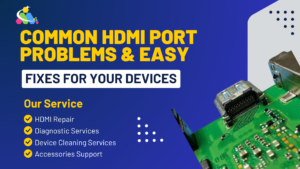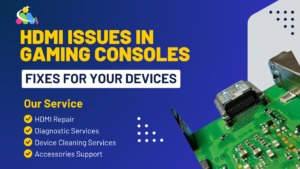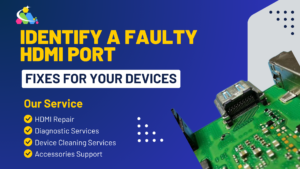HDMI, or High-Definition Multimedia Interface, is essential for modern gaming consoles. It delivers high-quality video and audio from the console to a TV or monitor, ensuring smooth and immersive gameplay. Whether you use a PlayStation, Xbox, or Nintendo Switch, a reliable HDMI connection is necessary for clear visuals and lag-free gaming. HDMI issues in gaming consoles are serious issues in the world.
Despite its importance, HDMI connections can develop problems over time. Issues such as no signal errors, flickering screens, or distorted audio can affect your gaming experience. Understanding these problems and knowing how to fix them can save time and frustration.
Why HDMI is Important for Gaming Consoles
HDMI technology allows gaming consoles to transmit high-definition visuals and surround sound. This connection supports 4K and HDR gaming, enhances refresh rates, and reduces input lag. A properly functioning HDMI cable and port ensure a seamless gaming experience without disruptions.
HDMI also plays a critical role in online multiplayer gaming. A weak or faulty connection can lead to lag, affecting gameplay and response time. Many modern consoles, including PlayStation 5 and Xbox Series X, use HDMI 2.1, which supports high refresh rates and low latency.
Common HDMI Issues in Gaming Consoles and Their Fixes

No Signal on TV or Monitor
One of the most frustrating problems is when the TV displays a “No Signal” message, even though the gaming console is powered on. This issue usually occurs due to a loose HDMI connection, a faulty cable, or incorrect input settings on the TV.
To fix this, start by checking the HDMI cable to ensure it is firmly connected to both the console and the TV. Try using a different HDMI cable to rule out cable damage. Make sure the TV is set to the correct HDMI input. If the problem persists, power cycle the devices by turning them off, unplugging them, waiting for a few seconds, and then restarting.
Loose or Damaged HDMI Port
A loose HDMI port can cause connection issues, leading to an unstable or non-existent display. If the HDMI port on the console feels wobbly or if the connection is inconsistent, the port might be damaged.
Inspect the HDMI port for any dust, bent pins, or visible damage. Cleaning the port with compressed air can remove dirt that might be affecting the connection. If the port is physically damaged, professional repair is recommended to avoid further complications.
Flickering or Black Screen During Gameplay
A flickering screen or intermittent blackouts can be caused by a faulty HDMI cable, an incompatible refresh rate, or issues with the TV’s HDMI ports.
Using a high-speed HDMI cable that supports 4K and 120Hz refresh rates can help eliminate flickering issues. Lowering the resolution or refresh rate in the console’s settings may also stabilize the display. If the problem persists, try switching to a different HDMI port on the TV, as some ports may have better compatibility.
Poor Audio or No Sound from HDMI
When video output works but there is no sound, the issue may be related to the console’s audio settings, the TV’s speaker configuration, or a damaged HDMI cable.
Check the console’s audio settings and ensure HDMI audio output is enabled. Selecting a different audio format, such as PCM or Dolby Digital, can resolve compatibility issues. If using an external sound system, verify the correct input source is selected. Testing with another HDMI cable can help determine if the issue is cable-related.
HDMI Port Bent or Broken
A damaged HDMI port can prevent the cable from fitting securely, resulting in no signal or flickering screens. A bent or broken port requires immediate attention to prevent further damage to the console’s motherboard.
If the HDMI port appears physically damaged, avoid inserting the cable forcefully. Professional repair is necessary to fix or replace the port. Attempting DIY repairs can lead to additional damage, making the problem worse.
Tips to Maintain Your Gaming Console’s HDMI Port

Preventing HDMI issues in gaming consoles is easier than fixing them. Proper maintenance can extend the lifespan of your gaming console’s HDMI port and ensure a stable connection.
Using high-quality HDMI cables reduces the risk of wear and tear. Cheap cables may fail quickly, leading to frequent connection problems. Avoid excessive plugging and unplugging of the HDMI cable, as this can loosen the port over time.
Keeping the gaming console on a stable surface prevents strain on the HDMI connection. If the console is frequently moved, consider using an HDMI extension or switcher to reduce direct wear on the port. Regularly cleaning the HDMI port with compressed air helps remove dust and debris that may interfere with the connection.
When to Seek Professional HDMI Repair
If troubleshooting does not resolve the issue, professional repair may be necessary. A damaged HDMI port or persistent connection problems can interfere with gaming performance and should be addressed by an expert.
Signs that indicate the need for professional HDMI repair include a broken or bent port, a connection that only works when the cable is held in a certain position, or continuous signal loss even after replacing the HDMI cable. A professional technician can safely repair or replace the HDMI port, restoring the console’s functionality.
Conclusion
HDMI plays a crucial role in gaming consoles, providing high-quality video and audio output. However, issues like no signal errors, flickering screens, or broken HDMI ports can affect gameplay. By following proper troubleshooting steps, most HDMI problems can be fixed at home.
Regular maintenance of the HDMI port and cable helps prevent common connection issues. If severe damage occurs, seeking professional repair ensures the console remains in optimal condition. Maintaining a stable HDMI connection enhances the overall gaming experience, allowing for smooth, uninterrupted gameplay.





